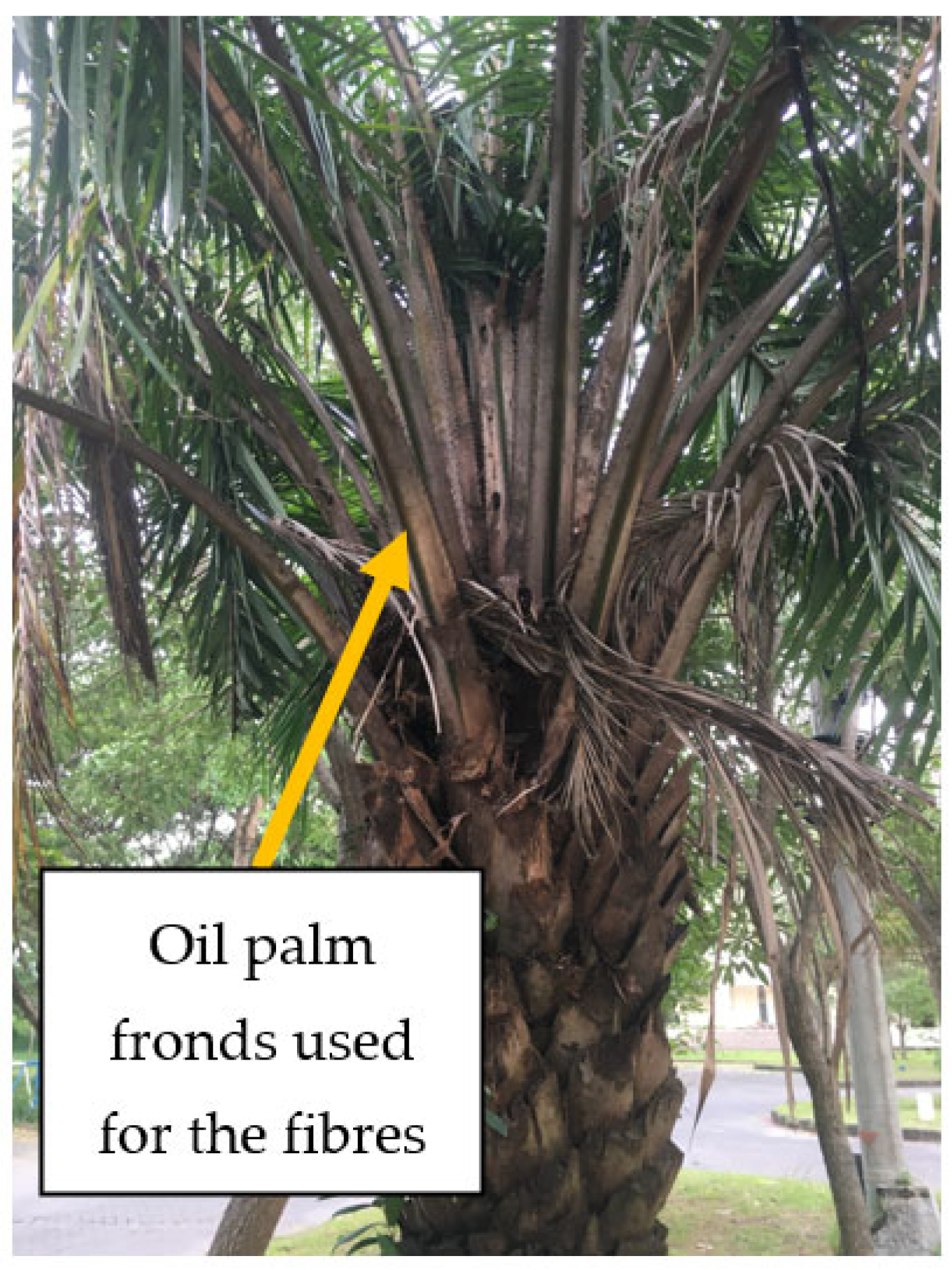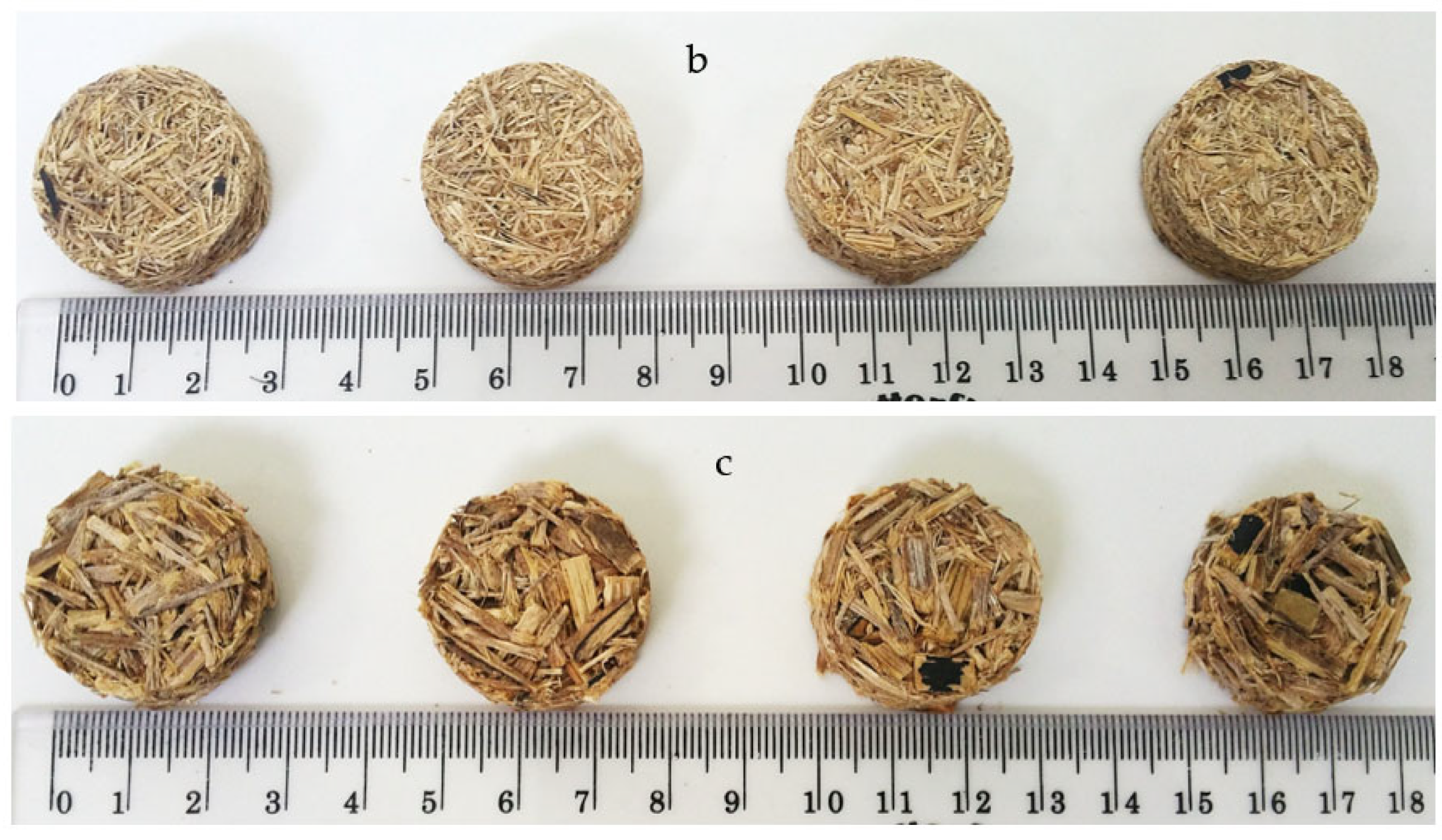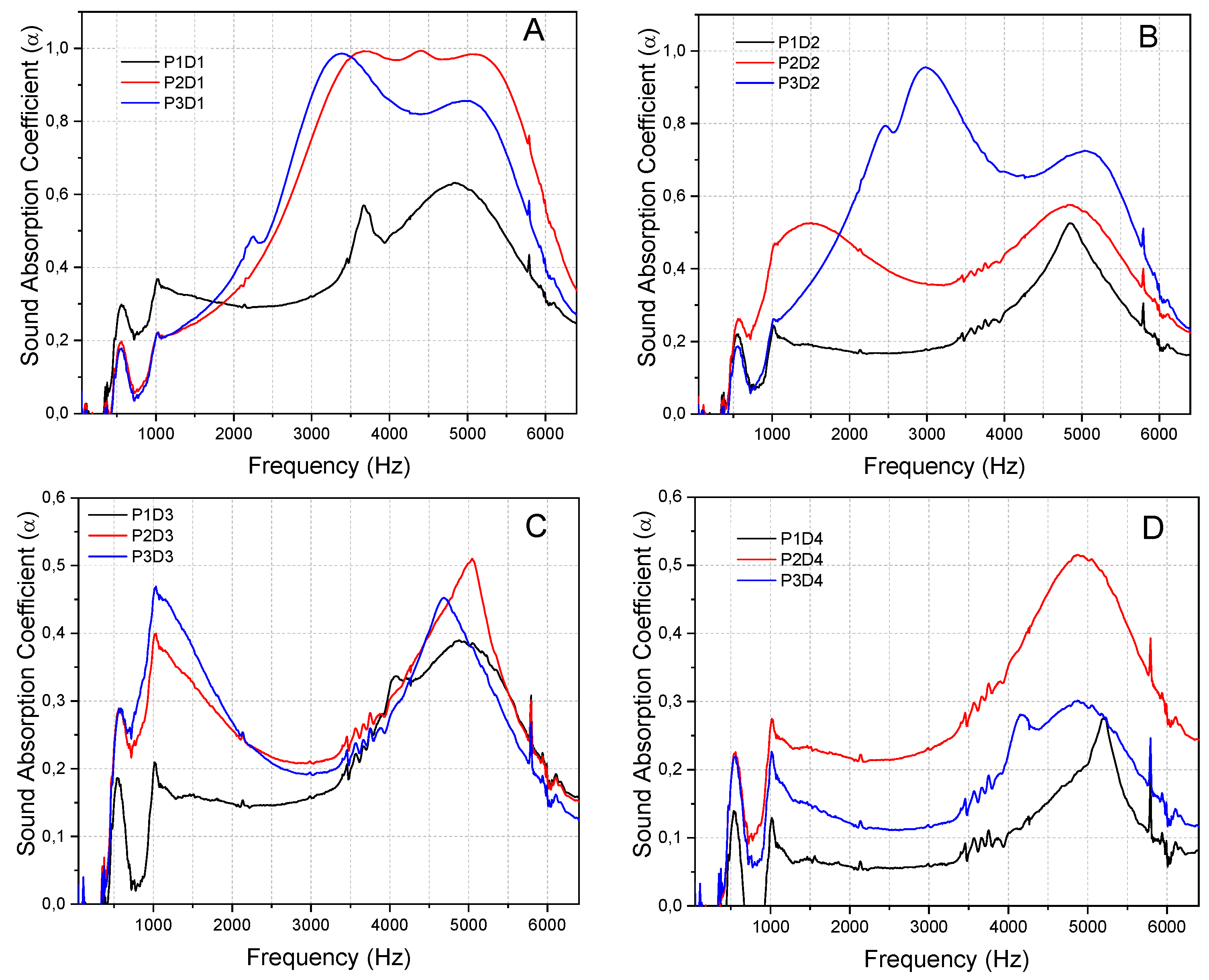Influence of Particle Size and Bulk Density on Sound Absorption Performance of Oil Palm Frond-Reinforced Composites Particleboard
Abstract
:1. Introduction
2. Materials and Methods
2.1. Materials
2.2. Preparations of Samples
2.3. Measurement of Sound Absorption Coefficient (SAC)
3. Results and Discussion
3.1. Effect of Particle Size
3.2. Effect of Bulk Density
3.3. Comparison with Commercial Wood
4. Conclusions
Author Contributions
Funding
Institutional Review Board Statement
Data Availability Statement
Acknowledgments
Conflicts of Interest
References
- BPS–Statistics Indonesia. Indonesian Oil Palm Statistics 2020, 05100.2111; BPS-Statistics Indonesia: Central Jakarta, Indonesia, 2020. [Google Scholar]
- Zin, Z.Z.; Tarmizi, A.M. Penggunaan bahan sampingan industri kelapa sawit. In Proceedings of the Bengkel Pemindahan Teknologi Perusahaan Kelapa Sawit, Serdang, Selangor, Malaysia, 7–8 November 1983; pp. 37–42. [Google Scholar]
- Yusof, B.; Chan, K.; Jalani, B.S. Advances in Oil Palm Research; Malaysian Palm Oil Board (MPOB): Selangor, Malaysia, 2000. [Google Scholar]
- Laemsak, N.; Okuma, M. Development of boards made from oil palm frond II: Properties of binderless boards from steam-exploded fibers of oil palm frond. J. Wood Sci. 2000, 46, 322–326. [Google Scholar] [CrossRef]
- Rasat, M.S.M.; Wahab, R.; Sulaiman, O.; Moktar, J.; Rasat, S. Properties of composite boards from oil palm frond agricultural waste. Boards 2011, 6, 4389–4403. [Google Scholar] [CrossRef]
- Rahman, H.A.A.; The Properties of Three Layer Particleboard from Oil Palm Fronds (Elaeis Guineensis). ir.Uitm.Edu.My. 2013. Available online: http://ir.uitm.edu.my/id/eprint/22810/ (accessed on 31 July 2022).
- Wahab, M.S.M.R.R.; Fauzi, M.N.M.; Hashim, N.; Samsi, W.R.S.M.; Razak, G.M.H. Processing and Properties of Oil Palm Fronds Composite Boards from Elaeis Guineensis. in Intech. 2012. p. 13. Available online: https://www.intechopen.com/chapters/77099 (accessed on 3 November 2022).
- Wahab, R.; Rasat, M.; Sulaiman, O.; Khalid, I. Properties of Bio-Composite Lumber from Oil Palm Fronds Agriculture Waste. 2011. Available online: http://umkeprints.umk.edu.my/id/eprint/540 (accessed on 9 March 2022).
- Pickering, K.L.; Aruan Efendy, M.G.; Le, T.M. A review of recent developments in natural fibre composites and their mechanical performance. Compos. Part A Appl. Sci. Manuf. 2016, 83, 98–112. [Google Scholar] [CrossRef] [Green Version]
- Asdrubali, F.; D’Alessandro, F.; Schiavoni, S. A review of unconventional sustainable building insulation materials. Sustain. Mater. Technol. 2015, 4, 1–17. [Google Scholar] [CrossRef]
- Joshi, S.V.; Drzal, L.T.; Mohanty, A.K.; Arora, S. Are natural fiber composites environmentally superior to glass fiber reinforced composites? Compos. Part A Appl. Sci. Manuf. 2004, 35, 371–376. [Google Scholar] [CrossRef]
- Prasad, A.R.; Rao, K.M. Mechanical properties of natural fibre reinforced polyester composites: Jowar, sisal and bamboo. Mater. Des. 2011, 32, 4658–4663. [Google Scholar] [CrossRef]
- Sihabut, T.; Lamsak, N. Sound Absorption Efficiency of Fibreboard Made from Oil Palm Frond. In Proceedings of the FORTROP II International Conference, Bangkok, Thailand, 17–20 November 2008. [Google Scholar]
- Mehrzad, S.; Taban, E.; Soltani, P.; Samaei, S.E.; Khavanin, A. Sugarcane bagasse waste fibers as novel thermal insulation and sound-absorbing materials for application in sustainable buildings. Build. Environ. 2022, 211, 108753. [Google Scholar] [CrossRef]
- Taban, E.; Amininasab, S.; Soltani, P.; Berardi, U.; Abdi, D.D.; Samaei, S.E. Use of date palm waste fibers as sound absorption material. J. Build. Eng. 2021, 41, 102752. [Google Scholar] [CrossRef]
- Abdi, D.D.; Monazzam, M.; Taban, E.; Putra, A.; Golbabaei, F.; Khadem, M. Sound absorption performance of natural fiber composite from chrome shave and coffee silver skin. Appl. Acoust. 2021, 182, 108264. [Google Scholar] [CrossRef]
- Taban, E.; Valipour, F.; Abdi, D.D.; Amininasab, S. Mathematical and experimental investigation of sound absorption behavior of sustainable kenaf fiber at low frequency. Int. J. Environ. Sci. Technol. 2020, 18, 2765–2780. [Google Scholar] [CrossRef]
- Malawade, U.A.; Jadhav, M. Investigation of the Acoustic Performance of Bagasse. J. Mater. Res. Technol. 2019, 9, 882–889. [Google Scholar] [CrossRef]
- Taban, E.; Tajpoor, A.; Faridan, M.; Samaei, S.E.; Beheshti, M.H. Acoustic Absorption Characterization and Prediction of Natural Coir Fibers. Acoust. Aust. 2019, 47, 67–77. [Google Scholar] [CrossRef]
- Lim, Z.; Putra, A.; Nor, M.; Yaakob, M. Sound absorption performance of natural kenaf fibres. Appl. Acoust. 2018, 130, 107–114. [Google Scholar] [CrossRef]
- Putra, A.; Or, K.H.; Selamat, M.Z.; Nor, M.J.M.; Hassan, M.H.; Prasetiyo, I. Sound absorption of extracted pineapple-leaf fibres. Appl. Acoust. 2018, 136, 9–15. [Google Scholar] [CrossRef]
- Berardi, U.; Iannace, G.; Di Gabriele, M. The Acoustic Characterization of Broom Fibers. J. Nat. Fibers 2017, 14, 858–863. [Google Scholar] [CrossRef]
- Or, K.H.; Putra, A.; Selamat, M.Z. Oil palm empty fruit bunch fibres as sustainable acoustic absorber. Appl. Acoust. 2017, 119, 9–16. [Google Scholar] [CrossRef]
- Othmani, C.; Taktak, M.; Zein, A.; Hentati, T.; Elnady, T.; Fakhfakh, T.; Haddar, M. Experimental and theoretical investigation of the acoustic performance of sugarcane wastes based material. Appl. Acoust. 2016, 109, 90–96. [Google Scholar] [CrossRef]
- Sihabut, T.; Laemsak, N. Sound Absorption Capacity of Oil Palm Frond Fiberboard with Different Finishing. Environ. Nat. Resour. 2010, 8, pp. 38–43. Available online: https://ph02.tci-thaijo.org/index.php/ennrj/article/view/82561 (accessed on 8 April 2022).
- Xu, J.; Widyorini, R.; Kawai, S. Properties of kenaf core binderless particleboard reinforced with kenaf bast fiber-woven sheets. J. Wood Sci. 2005, 51, 415–420. [Google Scholar] [CrossRef]
- Atar, I.; Nemli, G.; Ayrilmis, N.; Baharoğlu, M.; Sarı, B.; Bardak, S. Effects of hardener type, urea usage and conditioning period on the quality properties of particleboard. Mater. Des. 2014, 56, 91–96. [Google Scholar] [CrossRef]
- Product Data: Impedance Tube Kit Type 4206. Brüel & Kjær Sound & Vibration Measurement A/S, 2019, Nærum, Denmark. Available online: https://www.bksv.com/media/doc/bp1039.pdf (accessed on 8 April 2022).
- ISO-10534; Determination of Sound Absorption Coefficient and Impedance in Impedance Tubes. Part 2: Transfer-Function Method. ISO: Geneva, Switzerland, 1998; pp. 1–27.
- Chung, J.Y.; Blaser, D.A. Transfer function method of measuring in-duct acoustic properties. I. Theory. J. Acoust. Soc. Am. 1980, 68, 907–913. [Google Scholar] [CrossRef]
- Koruk, H. An assessment of the performance of impedance tube method. Noise Control Eng. J. 2014, 62, 264–274. [Google Scholar] [CrossRef]
- ASTM Standard E1050-90; Standard Test Method for Impedance and Absorption of Acoustical Materials Using a Tube. Two Microphones, and a Digital Frequency Analysis System. Annual Book of ASTM Standards. ASTM International: West Conshohocken, PA, USA, 1998.
- Ferrandez-García, M.T.; Ferrandez-Garcia, A.; Garcia-Ortuño, T.; Ferrandez-Garcia, C.E.; Ferrandez-Villena, M. Assessment of the Physical, Mechanical and Acoustic Properties of Arundo donax L. Biomass in Low Pressure and Temperature Particleboards. Polymers 2020, 12, 1361. [Google Scholar] [CrossRef] [PubMed]
- Yang, H.-S.; Kim, D.-J.; Kim, H.-J. Rice straw–wood particle composite for sound absorbing wooden construction materials. Bioresour. Technol. 2003, 86, 117–121. [Google Scholar] [CrossRef] [PubMed]
- Koizumi, T.; Tsujiuchi, N.; Adachi, A. The development of sound absorbing materials using natural bamboo fibers. WIT Trans. Built Environ. 2002, 59, 157–166. [Google Scholar] [CrossRef]
- Nandanwar, A.; Kiran, M.C.; Varadarajulu, K.C. Influence of Density on Sound Absorption Coefficient of Fibre Board. Open J. Acoust. 2017, 7, 1–9. [Google Scholar] [CrossRef] [Green Version]
- Flores, M.D.; Cravero, G.; Budde, L.; Longoni, H.; Ramos, O.A. Base de datos de coeficientes de absorción sonora de diferentes materiales. Mecánica Comput. 2013, 32, 2901–2908. [Google Scholar]
- ISO 11654; Acoustics—Sound Absorbers for Use in Buildings—Rating of Sound Absorption. British Standards Institution: London, UK, 1997.
- Zulkifli, R.; Nor, M.M.; Ismail, A.R.; Nuawi, M.Z.; Tahir, M.M. Effect of Perforated size and air gap thickness on acoustic properties of coir fibre sound absorption panels. Eur. J. Sci. Res. 2009, 28, 242–252. [Google Scholar]
- Taban, E.; Khavanin, A.; Ohadi, A.; Putra, A.; Jafari, A.J.; Faridan, M.; Soleimanian, A. Study on the acoustic characteristics of natural date palm fibres: Experimental and theoretical approaches. Build. Environ. 2019, 161, 106274. [Google Scholar] [CrossRef]







| Year | Fibres | Key Findings | References |
|---|---|---|---|
| 2022 | Sugarcane | The flow resistance and acoustic absorption coefficient increase as the fibre size decreases. | Mehrzad [14] |
| 2021 | Date palm | The statistical analysis revealed that the sample with 55 mm in thickness and 175 kg/m3 density had the optimum acoustic performance. | Taban [15] |
| 2021 | Coffee | The fibre size had no significant influence on the absorption coefficient, while the fibre ratio CS-CSS of 70:30 showed only a minor improvement over 50:50. | Abdi [16] |
| 2021 | Kenaf | The average absorption coefficient for samples with a density of 200 kg/m3 and a thickness of 45 mm was 0.96, 0.69, and 0.93, respectively, at 1 kHs. At 2 kHz, values of 0.93 are attainable with the same thickness and density. | Taban [17] |
| 2020 | Bagasse | The thickness of fibrous materials has a considerable influence on acoustic performance. The flow resistivity and acoustic absorption coefficient rise increase with material thickness. | Malawade [18] |
| 2019 | Coir | The sound absorption of thicker samples with constant densities was greater, particularly at lower frequencies (<1000 Hz). | Taban [19] |
| 2018 | Kenaf | The absorption coefficient for samples with a bulk density of 140–150 kg/m3 and a thickness of 25–30 mm is greater than 0.5 beginning at 500 Hz and can reach 0.85 on average above 1.5 kHz. | Putra [20] |
| 2018 | Pineapple | The average acoustic absorption coefficient for PALF is 0.9 above 2 kHz for a thickness of 20 mm and 0.8 above 1 kHz for a thickness of 30 mm for constant fibre density. | Putra [21] |
| 2017 | Broom | Sound absorption at lower frequencies is enhanced with increasing sample thickness, as would be expected for this type of material. | Berardi [22] |
| 2017 | Oil palm | Sound absorption performance can be improved by increasing sample thickness and optimizing fibre density. | Khai Hee Or [23] |
| 2016 | Sugarcane | The flow resistance and acoustic absorption coefficient increase as the fibre size decreases. | Othmani [24] |
| Type of Particle Size | Sample Code | Target Density (g/cm3) | Particle Size (mm) | Pressing Pressure (Mpa) | Pressing Time (Min) | Pressing Temp (°C) | No. of Boards |
|---|---|---|---|---|---|---|---|
| Fine | P1D1 | 0.3 | 0.2 to 0.6 | 1.0 | 5 | 140 | 1 |
| P1D2 | 0.4 | 1 | |||||
| P1D3 | 0.5 | 1 | |||||
| P1D4 | 0.6 | 1 | |||||
| Medium | P2D1 | 0.3 | 1.0 to 2.0 | 1.0 | 5 | 140 | 1 |
| P2D2 | 0.4 | 1 | |||||
| P2D3 | 0.5 | 1 | |||||
| P2D4 | 0.6 | 1 | |||||
| Coarse | P3D1 | 0.3 | 2.38 to 4.76 | 1.0 | 5 | 140 | 1 |
| P3D2 | 0.4 | 1 | |||||
| P3D3 | 0.5 | 1 | |||||
| P3D4 | 0.6 | 1 |
| Material | Sample Code | Thickness (mm) | Frequency | |||||
|---|---|---|---|---|---|---|---|---|
| 125 | 250 | 500 | 1000 | 2000 | 4000 | |||
| OPF | P1D1 | 10 | −0.02 | −0.02 | 0.25 | 0.36 | 0.30 | 0.48 |
| P2D1 | 10 | −0.03 | −0.02 | 0.16 | 0.21 | 0.33 | 0.97 | |
| P3D1 | 10 | −0.04 | −0.03 | 0.14 | 0.21 | 0.38 | 0.86 | |
| P1D2 | 10 | −0.03 | −0.01 | 0.19 | 0.23 | 0.17 | 0.28 | |
| P2D2 | 10 | −0.02 | −0.03 | 0.21 | 0.45 | 0.47 | 0.44 | |
| P3D2 | 10 | −0.03 | −0.03 | 0.15 | 0.25 | 0.56 | 0.67 | |
| P1D3 | 10 | −0.02 | −0.02 | 0.15 | 0.20 | 0.15 | 0.32 | |
| P2D3 | 10 | −0.04 | −0.02 | 0.24 | 0.39 | 0.26 | 0.30 | |
| P3D3 | 10 | −0.03 | −0.03 | 0.23 | 0.45 | 0.27 | 0.28 | |
| P1D4 | 10 | −0.05 | −0.04 | 0.11 | 0.12 | 0.06 | 0.11 | |
| P2D4 | 10 | −0.03 | −0.02 | 0.19 | 0.26 | 0.22 | 0.35 | |
| P3D4 | 10 | −0.02 | −0.02 | 0.19 | 0.21 | 0.12 | 0.22 | |
| Wood [37] | 25 | 0.19 | 0.14 | 0.09 | 0.06 | 0.06 | 0.05 | |
| Plywood [37] | 9 | 0.28 | 0.22 | 0.17 | 0.09 | 0.1 | 0.11 | |
| OPF perforated [25] | 12 | NA | 0.12 | 0.20 | 0.40 | 0.70 | NA | |
| Insulation classes [38] | - | - | E | D | D | A | ||
Disclaimer/Publisher’s Note: The statements, opinions and data contained in all publications are solely those of the individual author(s) and contributor(s) and not of MDPI and/or the editor(s). MDPI and/or the editor(s) disclaim responsibility for any injury to people or property resulting from any ideas, methods, instructions or products referred to in the content. |
© 2023 by the authors. Licensee MDPI, Basel, Switzerland. This article is an open access article distributed under the terms and conditions of the Creative Commons Attribution (CC BY) license (https://creativecommons.org/licenses/by/4.0/).
Share and Cite
Istana, B.; Batan, I.M.L.; Sutikno; Khem, S.; Ubaidillah, U.; Yahya, I. Influence of Particle Size and Bulk Density on Sound Absorption Performance of Oil Palm Frond-Reinforced Composites Particleboard. Polymers 2023, 15, 510. https://doi.org/10.3390/polym15030510
Istana B, Batan IML, Sutikno, Khem S, Ubaidillah U, Yahya I. Influence of Particle Size and Bulk Density on Sound Absorption Performance of Oil Palm Frond-Reinforced Composites Particleboard. Polymers. 2023; 15(3):510. https://doi.org/10.3390/polym15030510
Chicago/Turabian StyleIstana, Budi, I Made Londen Batan, Sutikno, Samrith Khem, U Ubaidillah, and Iwan Yahya. 2023. "Influence of Particle Size and Bulk Density on Sound Absorption Performance of Oil Palm Frond-Reinforced Composites Particleboard" Polymers 15, no. 3: 510. https://doi.org/10.3390/polym15030510
APA StyleIstana, B., Batan, I. M. L., Sutikno, Khem, S., Ubaidillah, U., & Yahya, I. (2023). Influence of Particle Size and Bulk Density on Sound Absorption Performance of Oil Palm Frond-Reinforced Composites Particleboard. Polymers, 15(3), 510. https://doi.org/10.3390/polym15030510








